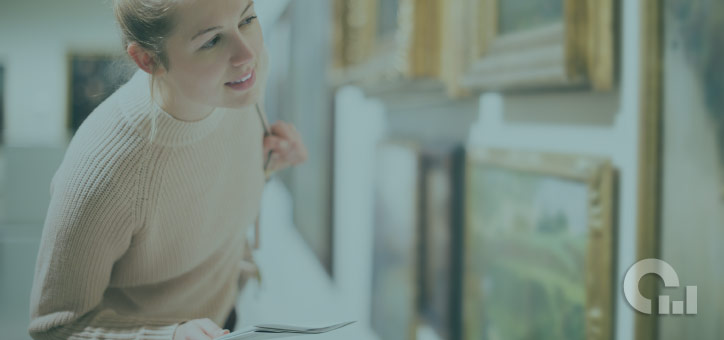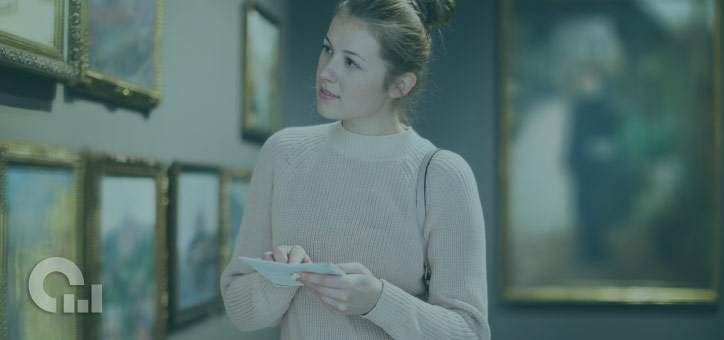Even if you’re not an art history major, courses in art history are a common requirement in college, providing a crucial part of a well-rounded education.
Some students take art history courses expecting an easy “A.” How difficult could it be, after all, to memorize the names of a few old artists and the date they painted their most well-known paintings or sculptured their most well-known sculpture?
The truth of the matter is art history is much more than that, and a far more difficult subject to study than many assume. Yes, names and dates are part of what it means to study art history, but so is placing the art in the historical, economic, and sociological context of its time. Studying art history also means you’ll know a lot more than the date when the artist was born and when their most well-known work was created.
Students of art history, instead, will need to fully understand an artist’s biographical timeline and how their life affected their work, from birth to old age. With this in mind, here’s how to study art history, both for art history majors, from bachelor’s to master’s, or students simply taking an online or in-person art history course for personal enrichment or to satisfy a liberal arts credit.
How to Study Art History
Here’s how to study art history to get the best grade possible.

Flashcards
Although art history is about more than just rote memorization of names and dates associated with well-known works of art, committing these points to memory will be a big part of an art history course, especially at the introductory level.
To this end, flashcards are an effective study tool. There are a number of ways to make art history flashcards, including cutting and pasting an image of the work of art on one side, with the name of the artist on the other.
Alternatively, make yourself a Keynote or PowerPoint presentation. Not only is quizzing yourself with the cards a useful way to study art history, but the act of making them will also help cement the important biographical and historical information in your memory.
Make a Spreadsheet
If you have a more linear mind, a spreadsheet might be a more effective study tool than flashcards. To make your spreadsheet, use software like Microsoft Excel or Numbers, for Mac users. Either way, make sure your spreadsheet includes the following information:
- Date the work was created
- Title of the piece
- Name of the artist
- The style
- The medium with which the artist was working
- Location of its origin
- The period in which it was created
Most often, students of art history will commit to memory works of art in chronological order, from oldest to newest. One advantage of using a spreadsheet, then, is that the information can be easily grouped and sorted by a variety of data points, bringing together all the sculptures, for instance, from across different periods of art. It may also be useful to add biographical information to the spreadsheet, such as gender and ethnicity.
Context Matters
In addition to simply knowing names, locations, and dates related to the work of art or period of art covered in an art history class, an art history instructor will likely expect students to understand some broader context in which the piece was created. These details could include major wars; plagues or pandemics; or the place that women, individuals, certain sexual orientations, or certain ethnic groups held within society at the time.
To this end, it would benefit students to seek out some additional reading material or to stay on top of any extra reading provided by the instructor. While exploring the context of the era, ask yourself questions like, “If the artist served in a war, how might that be reflected in their artistic output?” Or, “If the artist was a member of a marginalized community, how might that experience have affected their work?”
How to Study Art History: Additional Tips

As well as what we’ve already mentioned, here are some additional study tips applicable to more than just your art history class.
Follow the syllabus. It’s there for a reason, and try not to cram all your reading in at the last minute.
Take notes in class and attend the lectures. When it comes to college, showing up sometimes really can be half the battle.
Study outside your home. While it might be tempting to study somewhere comfortable, like your own bedroom, the fact of the matter is that familiar places are full of distractions. Head to the library or to a coffee shop instead. Go anywhere, really, where you’ll be able to tune in to studying and tune out that pile of laundry that still needs folding.
Listen to music. To help focus while studying, many people turn to classical music. If that doesn’t work for you, pick a partner from class to meet up with and quiz each other. Do whatever you need to do to get the work done.
Lastly, try to break up your studying into 20-minute sessions with a five- or 10-minute break in between, to rest your mind and refocus.
How to Study Art History: Endnotes
Studying art history means a lot more than just memorizing names and dates and attaching them to well-known works of art. To study art history is to fully understand the social and historical context of the art, as well as the important biographical details about the artist beyond when they were born and when they died.
Successful art history students use the following tools:
- Flashcards
- Spreadsheets
- Additional reading material for added context
Broadly speaking, the following tips help students study for all sorts of college courses, including art history:
- Follow the syllabus
- Take notes and attend class
- Study in a distraction-free environment
- Listen to music or study with a friend
There are no simple answers for getting good grades in college, but we hope this article provides a few useful tips for successfully studying art history and beyond.





